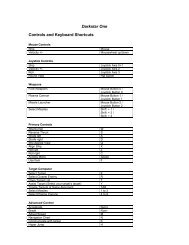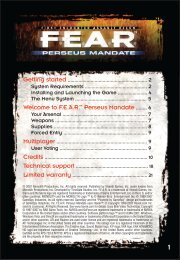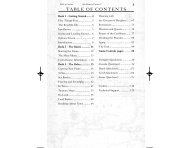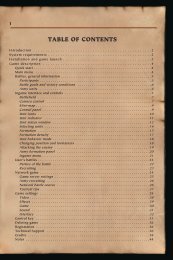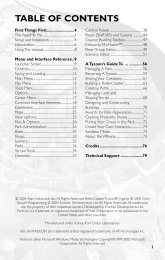Heads-Up Display Modes 35 - Metaboli
Heads-Up Display Modes 35 - Metaboli
Heads-Up Display Modes 35 - Metaboli
Create successful ePaper yourself
Turn your PDF publications into a flip-book with our unique Google optimized e-Paper software.
Sensors 73<br />
hYou cannot fire AIM-7 missiles when using TWS mode. You must<br />
designate the PDT or an SDT a second time and switch the radar to STT<br />
mode.<br />
Use TWS mode with caution. The radar cannot actually track multiple targets while<br />
scanning a large volume of airspace. Instead, the radar scans each target, predicts<br />
where the target will move to, searches a wider pattern, and then returns to scan<br />
the predicted position of each target. As long as the target flies a relatively<br />
consistent course, this system works fine; however, if the contact makes a<br />
sudden, aggressive course change, the radar will continue to show the predicted<br />
course until it completes enough of the scan cycle to realize it has lost contact<br />
with the target. The target may move a considerable distance unseen while the<br />
VSD continues to display the erroneous position.<br />
TWS is a powerful mode and necessary in order to fire multiple AIM-120 missiles<br />
at multiple targets. However, keep in mind its limitations and use it in conjunction<br />
with RWS and TWS modes.<br />
4.104 Home On Jam (HOJ) Mode<br />
If the radar detects a jamming signal, it displays a series of hollow rectangles<br />
along the bearing to the jammer on the VSD. If using AIM-7 or AIM-120 missiles,<br />
you may select and designate one of the Angle Of Jam (AOJ) rectangles. A<br />
vertical line appears through the AOJ markers and the VSD will display “HOJ”<br />
along the upper edge. Any AIM-7 or AIM-120 missiles will fly down the bearing of<br />
the jammer, attempting to locate the source.<br />
hThe AOJ markers only indicate the bearing to the jammer. It does not<br />
indicate the target’s speed, altitude, heading, or range.<br />
As you close on the jammer,<br />
eventually the reflections from<br />
your radar will be more powerful<br />
than the signals from the<br />
enemy’s jammer. This is called<br />
burn through and indicates your<br />
radar is powerful enough to<br />
overcome the jamming. Once<br />
you reach burn-through range,<br />
the contact will appear on the<br />
VSD, replacing the AOJ marks.<br />
HOJ display<br />
4.105 Vertical Search (VS) Auto-Acquisition Mode<br />
Vertical Search mode searches a fixed scan pattern 7.5° wide, ranging from 5°<br />
below the aircraft to 55° above. Range is fixed at 10 nautical miles. It<br />
automatically locks onto the target with the largest RCS within that pattern. After<br />
locking a target, the radar switches to STT mode.





